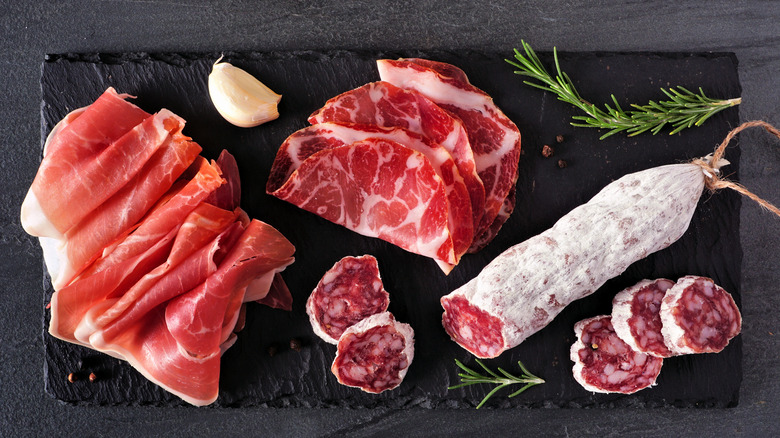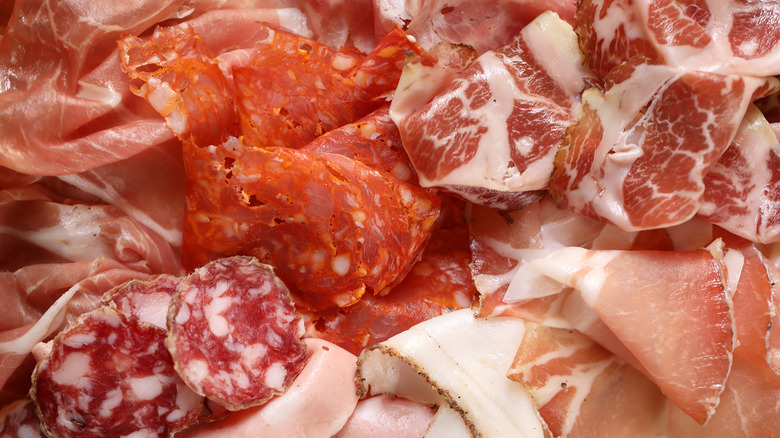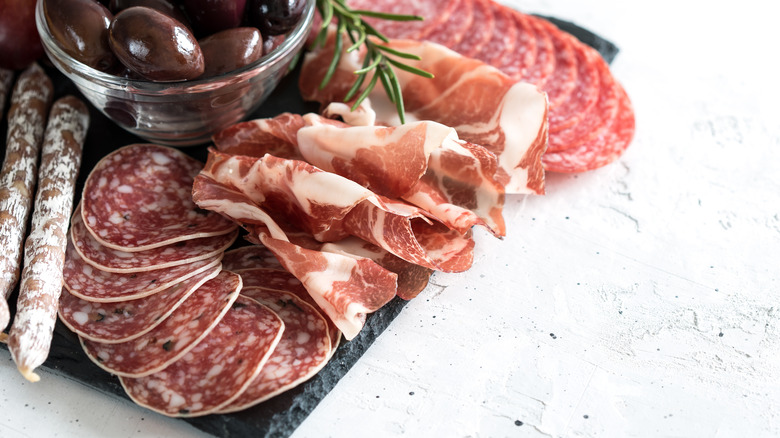Salumi Vs. Salami: What's The Difference?
Unless you work in an Italian deli, you probably wouldn't be able to identify the ins and outs of ham products like capicola, prosciutto, pancetta, and soppressata. Even if you know to expect great taste and high quality from Italian specialty meats, the specifics can get confusing. If you're a little hazy on the details, you're not alone.
Two words that are sometimes used interchangeably are "salumi" and "salami," but that one letter makes all the difference. Even though both are considered forms of Italian meats, these two terms are not the same. We'll break down each in detail below, but for now, know this: Salumi is a category of traditionally cured Italian ham as well as the term for the preparation process, whereas salami is Italian salt-cured or cooked sausage that is sometimes classified as traditional salumi.
It's kind of like knowing the difference between pancetta and bacon, so if you're confused, don't worry, you soon won't be.
What is salumi?
Salumi is an Italian term that generally refers to the craft of curing and preparing preserved meats. It is also used as an umbrella term to describe said meats, according to Salumi Chicago. The meat in question? Pork. Well, mostly. It seems that the definition of salumi differs depending on who you ask.
Traditional salumi, Bricco Salumeria shares, is derived from the major muscles of a pig — prosciutto, for example is the hind leg — and different cuts fall under a variety of categories. Aside from prosciutto, there's pancetta from the belly, coppa from the shoulder and neck area, and guanciale from the cheek, to name a few (via Rustico Cooking). As Serious Eats notes, all of these cuts classify as "whole muscle" salumi, and almost all of them are cured, specifically salted and dry-aged, which rids the meat of water and bacteria. Months to years in a temperature-controlled cellar give these cuts an intense flavor, too. Some of them are cooked before serving, like pancetta, while others are eaten as-is.
But again, salumi is an ever-evolving word. By definition, it's a craft. Product-wise, it varies. Traditionalists label only cured meats as salumi, but others include cooked variations, served hot or cold, that are not always pork.
What is salami?
Put simply, salami is a subset of salumi. But, not all forms of salumi are salami.
Salami comes in a myriad of flavors and forms, but it is essentially an Italian salt-cured, dried, fermented, or cooked sausage (via Serious Eats). The meat base, which can range from pork to beef to wild boar, is ground and combined with spices, additional fat, and wine, and then stuffed into casings, traditionally animal membranes like intestines.
Once assembled, the tubed-meat mixture is hung to dry and ferment. The fermenting process, which essentially cures the meat, uses salt to draw moisture out of the contents and prevent "spoilage bacteria" (via Meat and Sausages). This allows beneficial culture strains to thrive and give salami its distinct flavor. Popular dry-aged, hard salami varieties include sopressata and salame piccante (otherwise known in the U.S. as pepperoni), but salami comes in cooked forms too. You may have tried mortadella — a cooked salami cold cut speckled with black pepper and characteristic pistachio bits.
So, what's the difference?
If you're still confused, think of the term "salumi" as you would "charcuterie," the umbrella term used by the French for a variety of prepared meat products. Like charcuterie, salumi is used to describe a number of different meats, but specifically Italian cured ones. The salumi family encompasses all sorts of Italian cured meats, and that includes salami — the ground and seasoned meat that ferments in a sausage casing. But salami can't be used interchangeably with salumi, because not all salumi meats, like prosciutto or pancetta, are prepared like salami.
Now that you know the difference between these two Italian terms, how you choose to enjoy your salumi of choice is entirely up to you. Consider packing the traditional stuff, like thin, silky prosciutto, alongside your Brie, crackers and jam to finish off a charcuterie board. Stack slices of mortadella on a sandwich, or use thick cubes of pancetta in your weeknight carbonara. However you slice it, salumi will add a jolt of savory, salty flavor to whatever you desire.



